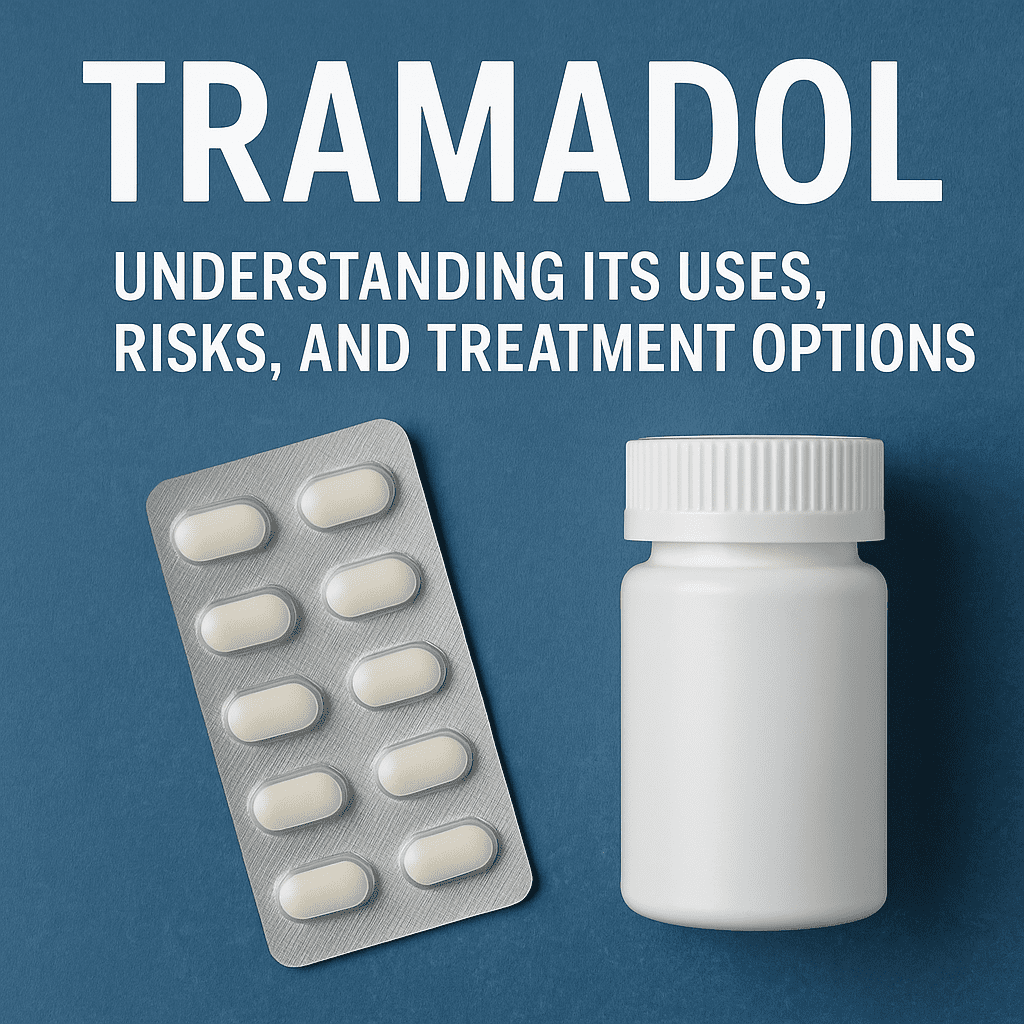Last Updated on August 27, 2025
Tramadol: Understanding Its Uses, Risks, and Treatment Options
What Is Tramadol?
Tramadol is a prescription medication classified as a synthetic opioid analgesic. It is commonly prescribed to manage moderate to moderately severe pain, particularly when other pain relievers are ineffective or unsuitable. Tramadol functions by binding to opioid receptors in the brain and inhibiting the reuptake of neurotransmitters such as serotonin and norepinephrine, which are involved in pain modulation.
What Is Tramadol Used For?
Pain Management
Tramadol is primarily used to alleviate pain resulting from various conditions, including:
-
Postoperative Pain: Following surgical procedures.
-
Chronic Pain Conditions: Such as osteoarthritis or back pain.
-
Neuropathic Pain: Pain caused by nerve damage.
It is available in immediate-release and extended-release formulations, allowing for flexibility in treatment plans.
Psychiatry
While not FDA-approved for psychiatric disorders, tramadol has been used off-label to manage conditions like anxiety and depression. However, this practice is controversial due to the risk of misuse and dependence.
Extended-Release Formulations
Extended-release tramadol is designed for around-the-clock pain management, providing consistent relief over a longer period. This formulation is typically used for chronic pain conditions requiring continuous opioid therapy .
Off-Label Uses
In some cases, tramadol has been prescribed for conditions such as restless leg syndrome and fibromyalgia, though these uses are not widely endorsed and should be approached with caution .
How Does Tramadol Work?
Tramadol exerts its analgesic effects through two primary mechanisms:
-
Opioid Receptor Agonism: Tramadol binds to mu-opioid receptors in the brain, mimicking the effects of endogenous opioids to reduce pain perception.
-
Serotonin and Norepinephrine Reuptake Inhibition: By inhibiting the reuptake of serotonin and norepinephrine, tramadol enhances the descending inhibitory pathways that modulate pain signals .
These combined actions contribute to tramadol’s effectiveness in pain management.
Can Tramadol Be Used With Other Medications?
Tramadol can interact with various medications, potentially leading to adverse effects:
-
With Alcohol: Concurrent use can increase the risk of central nervous system depression, leading to dizziness, drowsiness, and impaired cognitive function .
-
With Other CNS Depressants: Combining tramadol with sedatives, tranquilizers, or other opioids can enhance sedative effects and increase the risk of respiratory depression.
-
With Serotonergic Drugs: Using tramadol alongside drugs that increase serotonin levels (e.g., SSRIs, SNRIs) may elevate the risk of serotonin syndrome, a potentially life-threatening condition .
Always consult a healthcare provider before combining tramadol with other medications.
What Are the Possible Side Effects of Using Tramadol?
Common Side Effects
Tramadol may cause:
-
Dizziness and Drowsiness: Impairing the ability to perform tasks requiring alertness.
-
Nausea and Vomiting: Gastrointestinal disturbances.
-
Constipation: A common issue with opioid medications.
-
Headache: A frequent side effect.
Serious Side Effects
Less common but more severe effects include:
-
Seizures: Tramadol lowers the seizure threshold, increasing the risk.
-
Respiratory Depression: Slowed or difficult breathing, particularly dangerous in overdose situations.
-
Serotonin Syndrome: Symptoms include agitation, confusion, rapid heart rate, and high blood pressure, often occurring when combined with other serotonergic drugs .
Immediate medical attention is required if any of these serious side effects occur.
Is Tramadol Addictive?
Yes, tramadol has the potential for abuse and addiction. While it is considered less potent than other opioids, misuse can lead to physical and psychological dependence. The Drug Enforcement Administration (DEA) classified tramadol as a Schedule IV controlled substance in 2014, acknowledging its potential for abuse and dependence.
What Are the Withdrawal Symptoms of Tramadol Addiction?
Withdrawal from tramadol can be challenging and may include:
-
Emotional Symptoms: Anxiety, depression, and irritability.
-
Psychic Symptoms: Mood swings and difficulty concentrating.
-
Sleep Disorders: Insomnia or disturbed sleep patterns.
-
Gastrointestinal Symptoms: Nausea, vomiting, and diarrhea .
A medically supervised detox program is recommended to manage these symptoms safely.
Treatment Options for Tramadol Addiction
Effective treatment for tramadol addiction may involve:
-
Medication-Assisted Treatment (MAT): Using medications to reduce cravings and withdrawal symptoms.
-
Inpatient Treatment: Residential programs providing intensive therapy and support.
-
Outpatient Treatment: Less intensive programs allowing patients to live at home while receiving treatment.
-
Support Groups: Peer-led groups offering mutual support and shared experiences.
-
Holistic Treatments: Complementary therapies such as yoga, meditation, and acupuncture .
A comprehensive approach tailored to the individual’s needs is essential for successful recovery.
Conclusion
Tramadol is a valuable medication for managing moderate to severe pain when used appropriately under medical supervised detox. However, due to its potential for misuse and addiction, it is crucial to adhere strictly to prescribed dosages and be aware of possible side effects. If you or someone you know is struggling with tramadol use or addiction, seeking professional help is the first step toward recovery. Resources such as the Substance Abuse and Mental Health Services Administration (SAMHSA) provide confidential assistance and treatment referrals.
Remember, while tramadol can be effective for pain relief, it carries risks that should not be underestimated. Responsible use and awareness are key to ensuring its benefits outweigh potential harms.
Sources
[1] Tramadol. National Center for Biotechnology Information. (n.d.-a). https://www.ncbi.nlm.nih.gov/books/NBK537060/ on May 25, 2023
[2] Bumpus, J. A. (2020, October 29). Low-dose tramadol as an off-label antidepressant: A data mining analysis from the patients’ perspective. ACS pharmacology & translational science. https://www.ncbi.nlm.nih.gov/pmc/articles/PMC7737323/ on May 25, 2023
[3] Sansone, R. A., & Sansone, L. A. (2014, March). Serotonin norepinephrine reuptake inhibitors: A pharmacological comparison. Innovations in clinical neuroscience. https://www.ncbi.nlm.nih.gov/pmc/articles/PMC4008300/ on May 25, 2023
[4] Husic, S., Izic, S., Matic, S., & Sukalo, A. (2015, February). Efficacy and safety of a fixed combination of Tramadol and Paracetamol (acetaminophen) as pain therapy within Palliative Medicine. Materia socio-medica. https://www.ncbi.nlm.nih.gov/pmc/articles/PMC4384875/ on May 25, 2023
[5] Shah, K., Stout, B., & Caskey, H. (2020, July 11). Tramadol for the management of opioid withdrawal: A systematic review of randomized clinical trials. Cureus. https://www.ncbi.nlm.nih.gov/pmc/articles/PMC7417126/ on May 25, 2023
